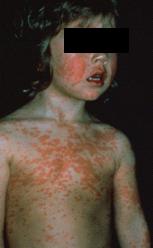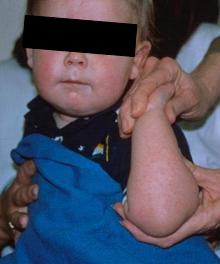Viral
You don't have to kiss a toad to get a wart.
Verruca vulgaris
Verruca vulgaris, also known as the common wart, is a manifestation of cutaneous infection with human papillomavirus (HPV) and presents as solitary papules with an irregular, rough surface. They are usually found on the extremities, but they may be found anywhere on the skin, including the scalp and oral and genital mucosa. Cutaneous infection with HPV also manifests in forms other than the common wart as well.
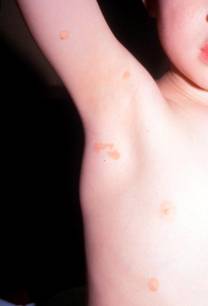
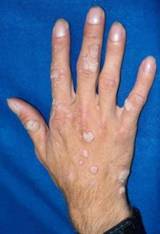
More Info: Warts (verruca vulgaris)
Molluscum contagiosum
Molluscum contagiosum is a self-limited epidermal poxvirus infection that presents as skin-colored, shiny papules that are often umbilicated.
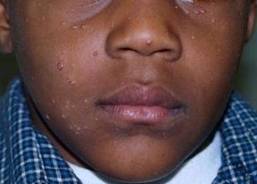
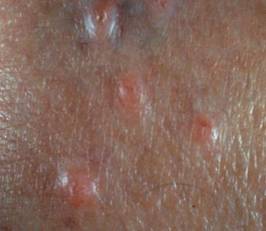
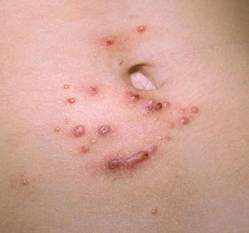
More Info:Molluscum contagiosum
Herpes simplex virus
Herpes simplex virus (HSV) infections present as grouped vesicles on an erythematous base, but occasionally only nonspecific crusted erosions are seen. Once an individual is infected, HSV persists in sensory ganglia for the life of the patient, recurring with lessening immunity. There are two main subtypes of HSV. HSV-1 tends to infect the orofacial areas more often, whereas HSV-2 tends to infect the anogenital regions more often, although either one can affect either site. HSV is primarily spread through skin to skin contact.
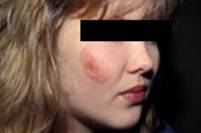
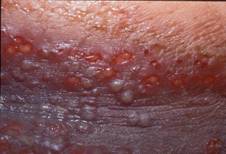
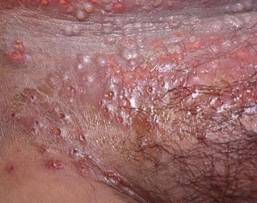
More information: herpes simplex virus (HSV)
Varicella
Varicella (aka the chickenpox) is a contagious primary infection caused by varicella-zoster virus (VZV). It is characterized by successive crops of pruritic vesicles that evolve to pustules, crusts, and occasionally, scars. Vesicles appear as "dewdrops on a rose petal." This infection is often accompanied by mild constitutional symptoms. VZV is spread via respiratory secretions as well as contact with cutaneous lesions.
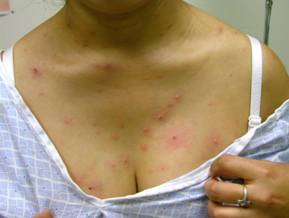
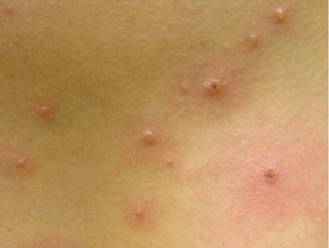
More Info: Varicella (chickenpox)
Herpes zoster
Herpes zoster, commonly known as shingles, is a disease caused by reactivation of VZV. It is more often found in adults than children. It is characterized by unilateral nerve pain and a vesicular or bullous eruption limited to one or two dermatomes innervated by a corresponding sensory ganglia. The major morbidity with herpes zoster is postherpetic neuralgia, which is quite painful.
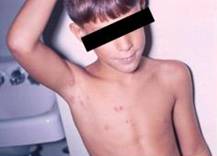
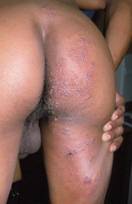
Measles
Measles, aka rubeola, is a contagious childhood viral infection characterized by fever, coryza (acute rhinitis), cough, conjunctivitis, and cutaneous and mucosal lesions. The cutaneous exanthem develops around the 4th febrile day and begins on the forehead and progresses to involve the face, trunk, and then extremities. It is a morbilliform eruption which means it presents as generalized, discrete, red to pink macules. The mucosal enanthem is known as Koplik's spots and are characterized as tiny bluish-white papules with an erythematous base on the buccal mucosa opposite premolar teeth. Childhood vaccination is highly effective at preventing infection.
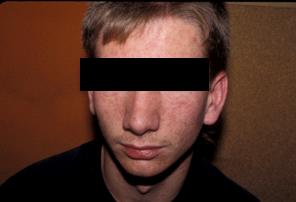
Rubella
Rubella, aka German measles, is a common benign childhood illness manifested by lymphadenopathy and an exanthem that begins as pink macules and papules on the forehead and spreads inferiorly to the face, trunk, and extremities during the first day. On the second day, the facial exanthem fades; and by the third day the exanthem fades completely. Rubella infecting a pregnant female produces a benign illness in the mother but results in congenital rubella syndrome with serious chronic fetal infection and malformation. Childhood vaccination is highly effective at preventing infection.
More Info: Rubella (German measles)
Hand-foot-mouth disease
Hand-foot-and-mouth, disease also known as vesicular stomatitis with exanthema, can be seen in children and infants. The most common agent is Coxsackie A16. The lesions are characteristically shallow ulcers on the hand, feet, and mouth, but also frequently on the buttocks.
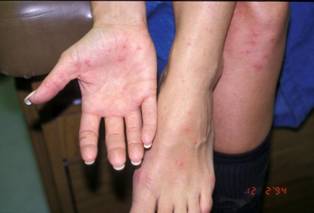
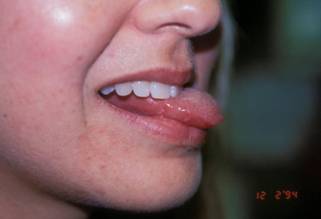
Hand-foot-mouth disease
More Info: Hand-foot-mouth disease
Roseola
Classic roseola, also known as exanthema subitum, is characterized by high fever (~104 degrees F) which suddenly disappears after 3 days only to be followed by eruption of the exanthem. The exanthem consists of faint pink macules, predominantly on the trunk. Roseola is believed to be one of the major causes of febrile seizures. Toddlers are most often affected. Classic roseola only accounts for approximately 25% of cases; other manifestations are rash alone, respiratory or gastrointestinal symptoms with rash, and nonspecific febrile illness. Lymphadenopathy and periorbital edema are occasionally seen.
Erythema infectiosum
Erythema infectiosum (EI), also known as "fifth disease" is caused by Parvovirus B19. The eruption begins as a confluent erythema of both cheeks, called the "slapped-cheek" appearance. It then spreads to the arms, legs, chest and abdomen with a reticulated (lace-like), pink-to-dull red macular eruption. A purpuric hand and foot eruption may occur.
